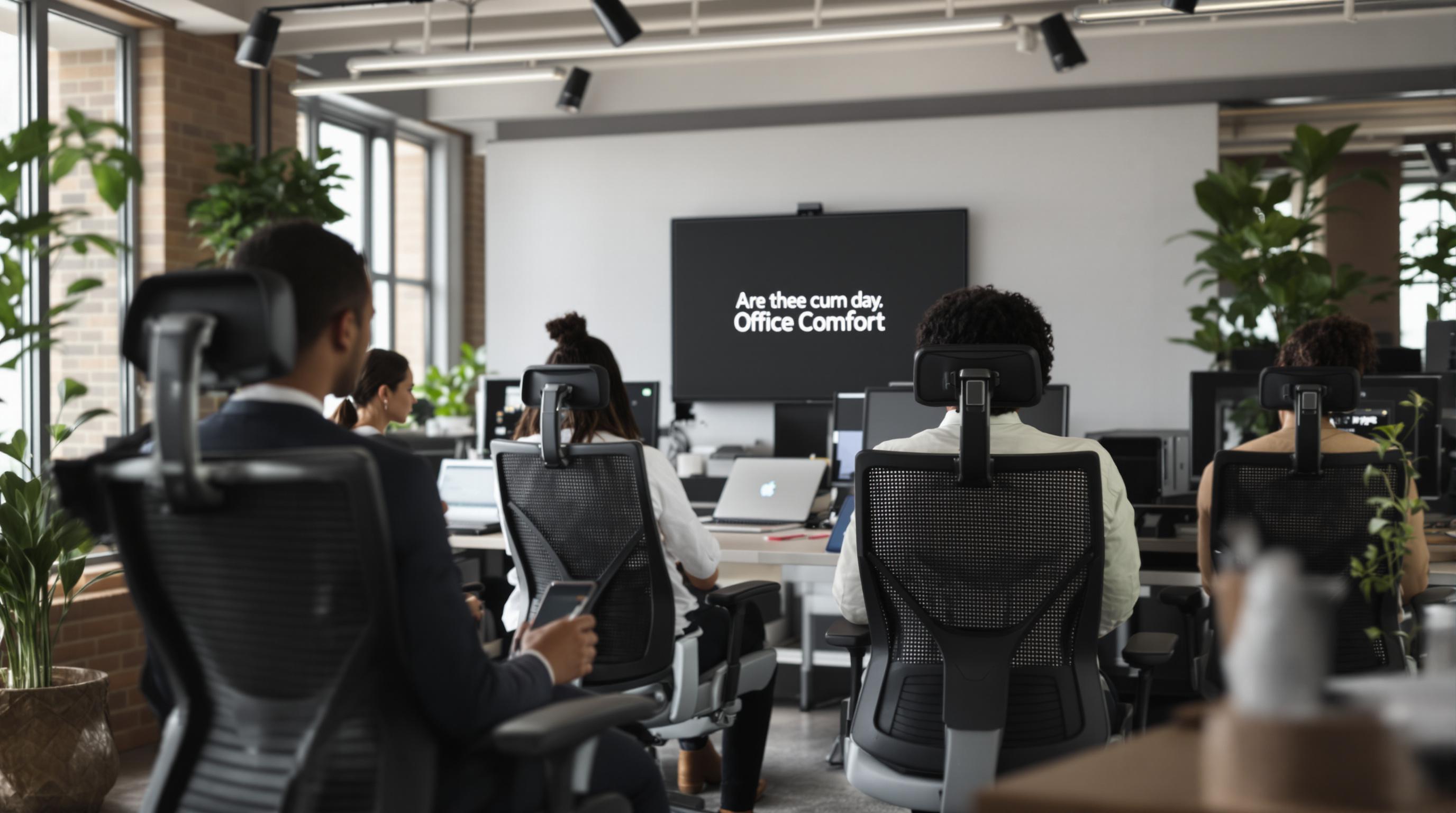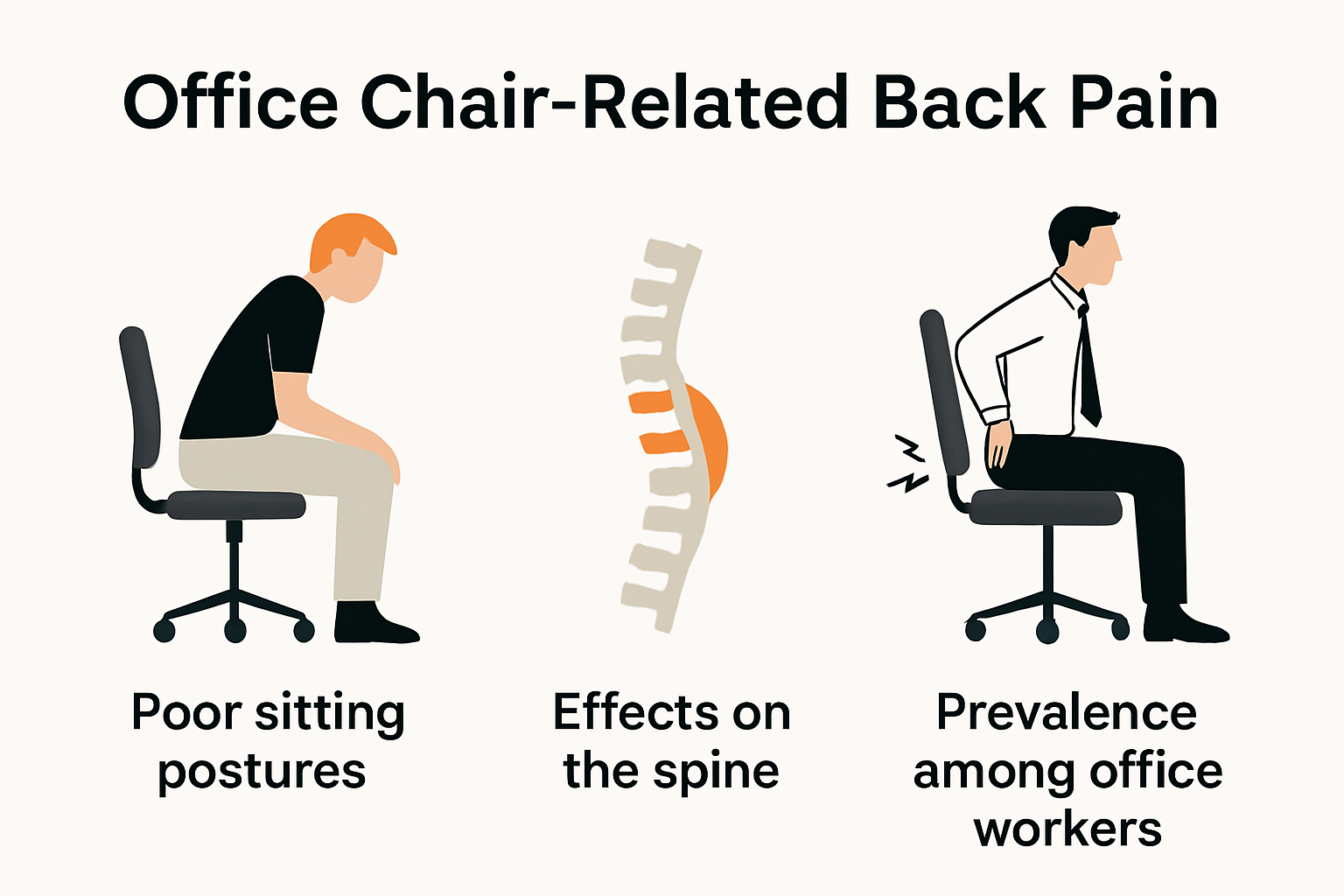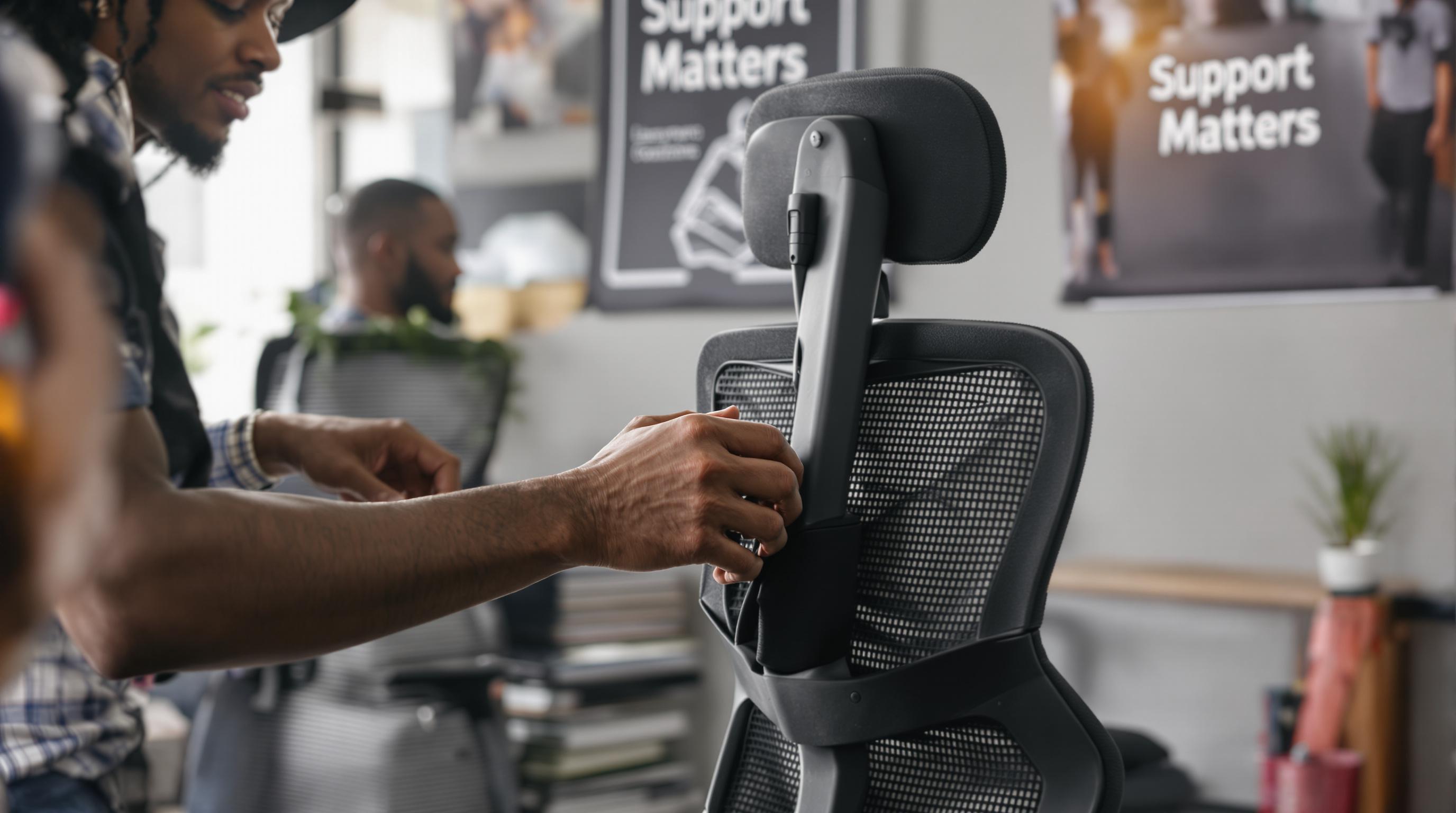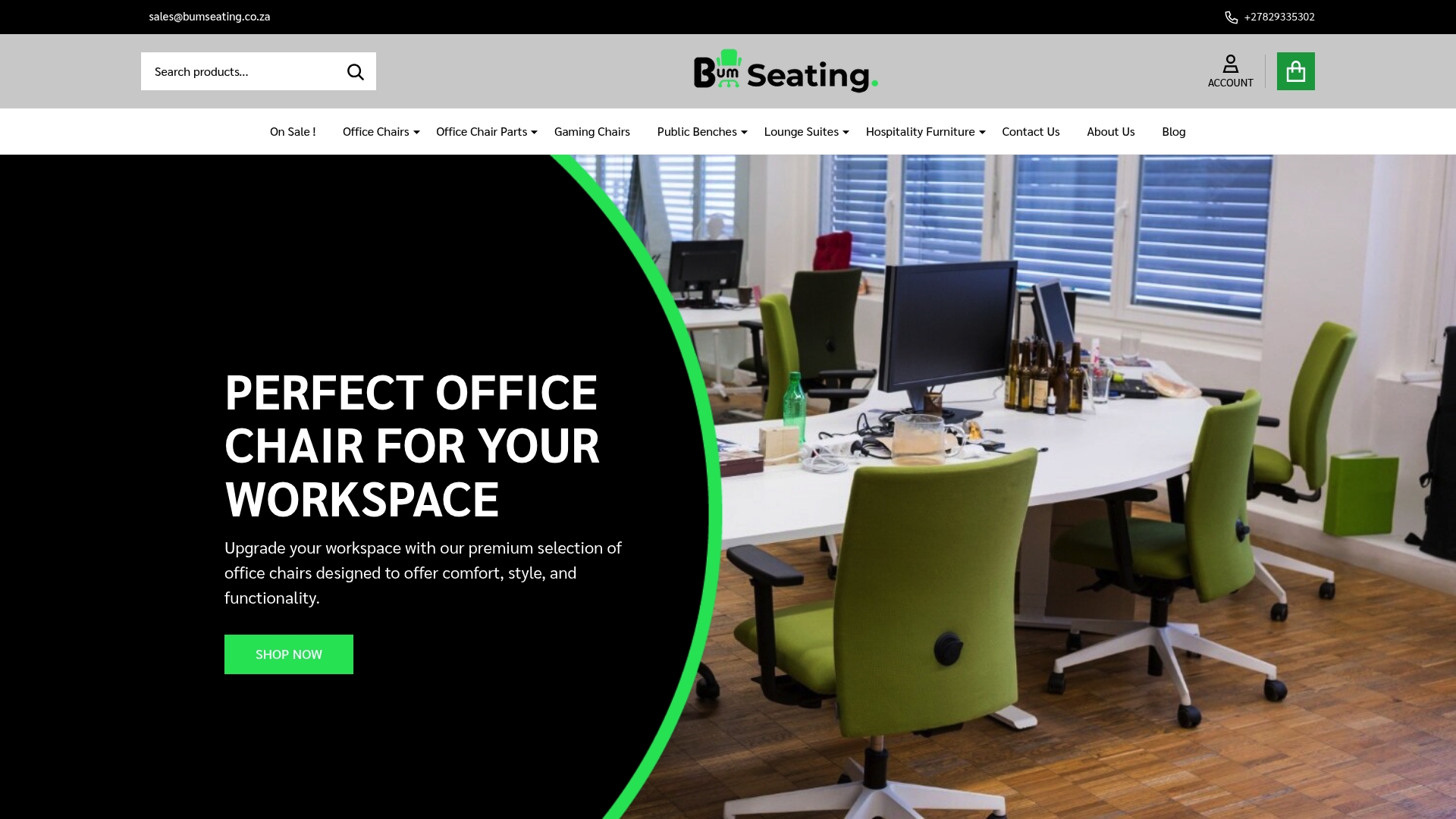Top Back Pain Office Chair Fixes for South African Workspaces 2025
Top Back Pain Office Chair Fixes for South African Workspaces 2025

Back pain has crept into almost every South African office and nearly 80 percent of desk workers report lower back discomfort at some point in their careers. Most people think a fancy new chair will make all the difference. But small adjustments to the chair you already have can actually fix most daily aches and save you a fortune in the process.
Table of Contents
- Understanding Back Pain From Office Chairs
- Essential Chair Features For Pain Prevention
- Practical Office Chair Fixes For Better Comfort
- Expert Tips For Choosing The Right Chair In South Africa
Quick Summary
| Takeaway | Explanation |
|---|---|
| Lumbar Support is Essential | A chair must provide adjustable lumbar support to maintain the spine’s natural curve and prevent muscle strain and disc compression. |
| Adjustability Matters | Office chairs should have multiple adjustability points, including seat height, backrest tilt, and armrest positioning, to cater to individual ergonomic needs. |
| Optimize Your Sitting Posture | Proper chair configuration is vital; adjust your chair for full lumbar support, maintain feet flat on the floor, and keep knees at a 90-degree angle to distribute body weight evenly. |
| Incorporate Movement Strategies | Implement the 20-8-2 rule: sit for 20 minutes, stand for 8 minutes, and move for 2 minutes to prevent stiffness and promote circulation. |
| Regular Maintenance is Key | Conduct quarterly inspections and maintenance of chair components to ensure consistent support and prolong the life of your ergonomic investment. |
Understanding Back Pain from Office Chairs
Office workers across South Africa face a silent yet pervasive health challenge: chronic back pain caused by poorly designed seating. Bum Seating recognizes that understanding the root causes of workplace discomfort is the first step towards creating healthier work environments.
The Biomechanics of Workplace Discomfort
The human spine is an intricate system designed for movement, not prolonged static positioning. According to the Centers for Disease Control and Prevention, poorly designed office chairs can significantly contribute to musculoskeletal disorders. When workers sit for extended periods without proper support, several critical biomechanical issues emerge.
The lumbar region bears the brunt of poor seating design. Without adequate support, the natural curvature of the spine becomes compromised, leading to increased pressure on vertebral discs and surrounding muscle groups. Research published in the International Journal of Environmental Research and Public Health reveals that sustained poor seating posture is a key risk factor for developing chronic lower back pain among office workers.

Impact of Prolonged Sitting on Spinal Health
Prolonged sitting creates a cascade of physiological challenges. Muscles become static, circulation reduces, and the spine experiences unnatural compression. The human body is fundamentally designed for movement, yet modern work environments often restrict natural mobility.
Occupational health experts highlight that sedentary work environments can lead to significant long-term health consequences. OSHA’s ergonomics guidance emphasizes that back pain is a leading cause of workplace disability, directly linked to inappropriate seating solutions.
For South African professionals seeking comprehensive solutions, our guide on ergonomic seating strategies offers in-depth insights into creating supportive work environments.
Recognizing Early Warning Signs
Identifying potential back issues early can prevent long-term complications. Common symptoms include persistent lower back discomfort, increased muscle tension, reduced flexibility, and occasional sharp pain during extended sitting periods. Workers should pay attention to:
- Persistent Lower Back Ache: Continuous discomfort that develops during work hours
- Reduced Mobility: Stiffness and difficulty moving after prolonged sitting
- Radiating Discomfort: Pain that extends from the lower back to legs or upper back
Bum Seating is committed to transforming workplace wellness by providing ergonomic solutions that prioritize spinal health and employee comfort. Understanding these challenges is the first crucial step towards creating healthier, more supportive work environments across South African businesses.
Essential Chair Features for Pain Prevention

Preventing back pain starts with selecting the right office chair. Bum Seating understands that not all chairs are created equal when it comes to supporting spinal health and workplace comfort.
Lumbar Support: The Foundation of Ergonomic Seating
Lumbar support is the cornerstone of effective back pain prevention. According to the National Institutes of Health, a well-designed chair must provide targeted support to the lower back’s natural curve. This critical feature helps maintain proper spinal alignment and reduces the risk of muscle strain and disc compression.
The ideal lumbar support should be adjustable, allowing workers to customize the chair to their unique body shape. Bum Seating’s ergonomic designs focus on creating dynamic support that moves with the user, preventing the static positioning that leads to chronic discomfort.
Adjustability: Customizing Comfort for Every Body
One-size-fits-all is a myth when it comes to office seating. The Occupational Safety and Health Administration emphasizes the importance of multiple adjustability points. Key features should include:
- Seat Height Adjustment: Enables users to position their feet flat on the floor
- Backrest Tilt and Tension Control: Allows dynamic movement and pressure distribution
- Armrest Positioning: Supports proper arm and shoulder alignment
Our comprehensive guide to adaptive seating solutions provides deeper insights into creating personalized workplace comfort.
Material and Design Considerations
Beyond mechanical features, the chair’s material plays a crucial role in back pain prevention. The Canadian Centre for Occupational Health and Safety recommends breathable materials that promote air circulation and reduce heat buildup.
Breathable mesh backs offer superior ventilation and flexibility, while high-density foam cushions provide consistent support without breaking down quickly. Memory foam technologies can adapt to individual body contours, distributing weight more evenly and reducing pressure points.
Bum Seating recognizes that preventing back pain is more than a technical challenge—it’s about creating chairs that support the human body’s natural movement and comfort. Our commitment to ergonomic excellence ensures that South African workers can maintain their health and productivity through intelligent seating design.
To help compare essential chair features mentioned above, the following table summarizes the main factors for pain prevention in an office chair:
| Feature | Description | Benefit |
|---|---|---|
| Adjustable Lumbar Support | Supports natural spinal curve; customisable for different users | Reduces strain and disc compression |
| Seat Height Adjustment | Lets feet rest flat on the floor for improved posture | Even weight distribution |
| Backrest Tilt & Tension Control | Allows the user to recline and move comfortably | Minimises pressure on spine |
| Adjustable Armrests | Enables arms and shoulders to align properly | Less upper body tension |
| Breathable Materials | Materials like mesh that prevent heat buildup | Cooling and comfort |
| High-Density/Memory Foam Cushion | Retains shape & adapts to user, distributes pressure | Prevents pressure points, supports |
| Robust Five-Point Base | Provides chair stability on any office floor | Safer and more durable |
Practical Office Chair Fixes for Better Comfort
South African professionals spend countless hours seated, making practical chair adjustments crucial for maintaining workplace wellness. Bum Seating understands that small modifications can significantly improve comfort and reduce the risk of chronic back pain.
Optimizing Sitting Posture and Chair Settings
Proper chair configuration is the first line of defense against workplace discomfort. The Occupational Safety and Health Administration recommends several strategic adjustments to enhance seating ergonomics.
Start by positioning the chair to support the natural spine curvature. Sit with your hips pushed far back in the seat, ensuring the lower back receives full support from the lumbar region. Adjust the seat height so your feet rest flat on the floor, with knees at a 90-degree angle. This positioning distributes body weight evenly and reduces unnecessary strain on the lower back and leg muscles.
The chair’s backrest should be tilted slightly backward, creating a reclined angle between 100 and 110 degrees. This position minimizes pressure on the spine and encourages a more relaxed, supported posture. For more detailed strategies on workspace optimization, explore our comprehensive seating guide.
To make the seating adjustment process easier, here’s a step-by-step table outlining optimal chair setup for comfort and back support:
| Adjustment Step | Action | Purpose/Benefit |
|---|---|---|
| Lumbar Support | Position lower back against chair with support | Maintains spinal curve, reduces strain |
| Seat Height | Adjust until feet are flat, knees at 90° | Even weight distribution, improves flow |
| Backrest Tilt | Set backrest between 100° – 110° | Reduces spinal pressure, supports relax |
| Hips Placement | Sit with hips far back in the seat | Promotes posture, uses lumbar properly |
| Armrest Height | Align armrests so shoulders are relaxed | Reduces upper body tension |
| Supplemental Cushion (if needed) | Add cushion/rolled towel for extra lumbar support | Enhances comfort for poor built-in lumbar |
| Footrest (if needed) | Use if feet don’t touch floor properly | Maintains correct leg alignment |
Supplementary Support and Movement Strategies
Beyond chair adjustments, incorporating additional support can dramatically improve comfort. Consider using a small cushion or rolled towel to enhance lumbar support if your chair’s built-in mechanism feels inadequate. Ergonomic accessories like footrests can help maintain proper leg positioning, especially for shorter individuals or those working with non-adjustable desks.
Movement is equally critical. Implement the 20-8-2 rule: 20 minutes sitting, 8 minutes standing, and 2 minutes moving or stretching. This approach prevents muscle stiffness and promotes blood circulation. Invest in a chair with swivel capabilities and wheels, allowing easy movement and position changes throughout the workday.
Maintenance and Long-Term Chair Care
Regular chair maintenance plays a crucial role in sustained comfort. Inspect your chair’s mechanical components quarterly, checking for loose screws, worn-out cushioning, or compromised support mechanisms. Replace worn-out chairs promptly, as degraded seating can exponentially increase the risk of developing musculoskeletal issues.
Periodically clean and lubricate moving parts to ensure smooth adjustments. Pay special attention to the seat’s padding and backrest, looking for signs of compression or uneven wear. A well-maintained chair not only provides consistent support but also extends the lifespan of your ergonomic investment.
Bum Seating is committed to empowering South African professionals with practical, actionable solutions for workplace comfort. By implementing these strategic fixes, workers can transform their seating experience, reducing back pain and enhancing overall productivity.
Expert Tips for Choosing the Right Chair in South Africa
Selecting the perfect office chair is more than a simple purchasing decision—it’s an investment in workplace health and productivity. Bum Seating understands that South African professionals require tailored seating solutions that address unique workplace challenges.
Understanding Individual Ergonomic Needs
Every worker’s body is different, and a chair that works for one person might not suit another. According to the National Institutes of Health, critical chair selection factors include individual body dimensions, work tasks, and specific physical requirements.
Key measurement considerations involve seat depth, backrest height, and overall chair dimensions. For South African workers, this means looking beyond generic sizing and focusing on chairs that offer extensive adjustability. Measure your body’s key dimensions—seat width, leg length, and torso height—before making a selection. Explore our comprehensive seating solutions to find chairs designed for precise customization.
Essential Features for South African Workspaces
The Canadian Centre for Occupational Health and Safety recommends prioritizing specific chair features that enhance comfort and support. In the South African context, consider chairs with:
- Breathable Materials: Critical for managing heat in warmer climates
- Robust Five-Point Base: Ensures stability on various floor surfaces
- Wide Seat Pan: Accommodates diverse body types
- Adjustable Lumbar Support: Provides personalized back comfort
Additionally, consider the chair’s durability and maintenance requirements. South African workspaces often experience varied environmental conditions, so selecting chairs with high-quality, resilient materials becomes paramount.
Professional Selection Strategy
Duke University’s Ergonomics Division emphasizes a strategic approach to chair selection. Begin by identifying your primary work requirements: Are you a programmer spending hours at a desk? A call center professional? A creative professional who moves between tasks?
Each work style demands slightly different seating solutions. For instance, programmers might prioritize chairs with extended back support, while creative professionals might need chairs allowing more dynamic movement. Test chairs in person whenever possible, paying attention to:
- Ease of adjustment mechanisms
- Comfort during extended sitting periods
- Range of motion and flexibility
- Weight distribution and pressure point management
Bum Seating recommends allocating sufficient time for chair selection—treat it as a critical investment in your professional health and productivity. Remember, the right chair can significantly reduce the risk of chronic back pain, improve workplace efficiency, and contribute to overall well-being.
By applying these expert strategies, South African professionals can transform their workspace into an ergonomic haven that supports both physical comfort and professional performance.
Frequently Asked Questions
What are the key features to look for in an office chair to prevent back pain?
Essential features include adjustable lumbar support, seat height adjustment, backrest tilt, and breathable materials. These features help maintain proper spinal alignment and improve overall comfort during long hours of sitting.
How can I adjust my existing office chair to reduce back pain?
To reduce back pain, sit all the way back in your chair, adjust the height so your feet are flat on the floor with knees at a 90-degree angle, and ensure the lumbar support aligns with the natural curve of your spine. Use the chair’s tilt feature to recline slightly for additional comfort.
What is the 20-8-2 rule, and how does it help prevent back pain?
The 20-8-2 rule suggests you sit for 20 minutes, stand for 8 minutes, and move for 2 minutes. This promotes circulation, reduces stiffness, and helps alleviate back pain by encouraging regular movement throughout the workday.
When should I consider replacing my office chair?
You should consider replacing your office chair if it shows signs of wear, such as broken or ineffective lumbar support, outdated design impacting your comfort, or if you experience chronic back pain despite adjustments. A new ergonomic chair can significantly improve your seating experience.
Turn Back Pain Relief Into Everyday Comfort With Bum Seating
You just read how most office chairs fall short on lumbar support, adjustability, and ergonomic design. The discomfort and fatigue are real, especially if you work long hours from a South African workspace. If your current chair leaves you stiff, sore, or constantly needing to reposition for relief, it is time to upgrade to a solution that prioritises your wellbeing.

Experience the difference when you invest in seating trusted by health-conscious professionals. Browse Bum Seating’s full office chair range and discover ergonomic chairs designed to protect your spine, support natural movement, and fit your unique workspace. Each product features detailed information, transparent pricing, and easy online purchasing. Do not wait for back pain to become a chronic problem. Visit https://bumseating.co.za and claim your comfort now.







